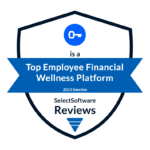In 2022, Americans’ financial health declined for the first time in five years. Between 2023 and 2024, several key financial health indicators got even worse. Today, 70% of Americans are considered financially unhealthy and seven out of 10 Americans are living paycheck to paycheck.
Despite that the 2024 Employee Benefits Research Institute (EBRI) Survey revealed that employers have become more aware of the need to support employees’ everyday money problems, investments and retirement planning remain the top-cited primary focus of employers’ financial wellness initiatives.
When 80% of Americans are worried about basic expenses including groceries and childcare, regardless of income, employers cannot expect 401(k) savings success if that is the only type of employee financial support offered.
Hardship withdrawals from retirement plans are at a 10-year high
According to T. Rowe Price, 2.5% of retirement plan participants took a hardship withdrawal in 2024 — the highest percentage in a decade. The average withdrawal was $11,739, up more than 30% from just two years ago.
This is not just a personal finance problem. This is a workplace financial health crisis.
Employees are dipping into their future because they have no better option today. That’s plan leakage —and it’s a clear sign that retirement benefits are not working for the majority of employees who are not financially healthy and need help the most.
Financially struggling employees aren’t focused on future needs
Brightside customers Ben Roberge, Director, Financial & Retirement Programs at Unum, and Cathy Stewart, SHRM-SCP, Director, Retirement Programs at a Fortune 10 employer, session moderator Mindy Field, Minneapolis Business Leader at Mercer, and Brightside CEO and Co-Founder Tom Spann discussed this topic like in a Be Well Conference session called “How Financial Care Drives ROI for Frontline Workers.”
As Fields pointed out, employees who are struggling aren’t focused on what might happen decades from now. “When you think about people that need help the most, they cannot even [begin to] save for retirement. They need help managing their day-to-day finances before they can even save and plan for the long term. Brightside Financial Care is an integral piece of that holistic financial wellness.”
Spann added that the employees with the funds to invest or save for retirement generally aren’t the same people whose poor financial health costs employers in the form of expenses like turnover and healthcare.
“To drive ROI, you have to engage the financially sick people. They don’t view financial planning or financial education as a relevant product. They think they’ll be told they’re doing it wrong. They are not going to proactively engage,” said Spann.
When employees have a benefit like Brightside that offers real solutions for their money emergencies, including safe loans that are tied to the paycheck and therefore offered at much lower interest rates than they could get elsewhere, and a free emergency savings account that makes it easy to put a little money aside each pay period, they start to build hope that they can improve their situation.
As employees are empowered and encouraged to take steps forward, they begin to see that there is a way of paying off debt, feeling less stretched between paychecks, and improving their financial health. Once they address these types of needs and see results, it’s far more likely that saving for retirement becomes a viable financial goal.
What’s the difference between Financial Care and a retirement benefit?
Most Fortune 500 employers offer employees a retirement savings plan, and it may include some type of financial education or planning. But that’s not enough to serve the financial needs of all employees – particularly those who are struggling.
The reality is, the vast majority of Americans are not thinking about planning for years or even decades away. As such, most employees who come to Brightside need help meeting their day-to-day financial needs.
These employees are matched with a Brightside Financial Assistant who is specifically trained to offer non-judgmental, empathetic support, and who works to build trust and understand the employee’s unique needs, motivators, and barriers to financial health.
With that information, the Financial Assistant offers options that will improve the employee’s financial situation. In some cases, this involves financial products from Brightside’s ecosystem of trusted, highly vetted financial partners. In urgent cases, the Financial Assistant will do the legwork to connect the employee with resources such as free money, food, and opportunities to subsidize necessities like housing and utilities.
Employees who do come to Brightside for needs like retirement planning and investing are matched with a Financial Assistant who is also a certified financial planner (CFP). Brightside also helps employees navigate other benefits offered by their employer, based on their specific situation.
For example, Unum encourages employees to go to Brightside for any financial need, so Brightside can help them find the best solution. “We leverage it more as a front door to come to first, and then Brightside will point you to wherever you need to go,” said Roberge.
This approach has been successful at Unum because it is core to helping employees see results, find solutions, and feel hopeful that they can improve their financial situation.
Unlike 401(k) vendors who have a business model that makes money from assets under management, Brightside’s mission is to improve the financial health of working families. We do this by helping them take the financial actions and next steps that truly support their financial best interests.
“The key to behavioral economics is to make the right things easy to do, in a very complex system. That’s what we’re doing at Brightside,” said Spann.
A better outcome for employees and employers
When employees don’t have to turn to their 401(k) in a crisis, everyone wins. Fewer hardship withdrawals mean less plan leakage, and when employees are connected with real financial solutions that address their urgent needs without sacrificing their financial health, less financially stressed employees. For employers, this also means reduced turnover, and more employees who are productive and engaged when they’re at work.
Learn more about how Brightside Financial Care helps employees meet urgent financial needs, reduce hardship withdrawals, and build long-term financial health.
This post was originally published on August 22, 2023. It has been updated to reflect more current data and insights.





